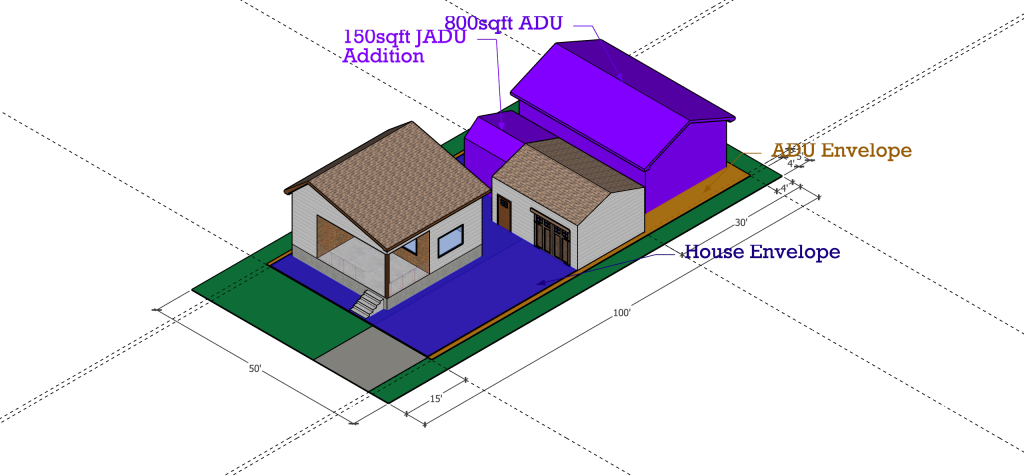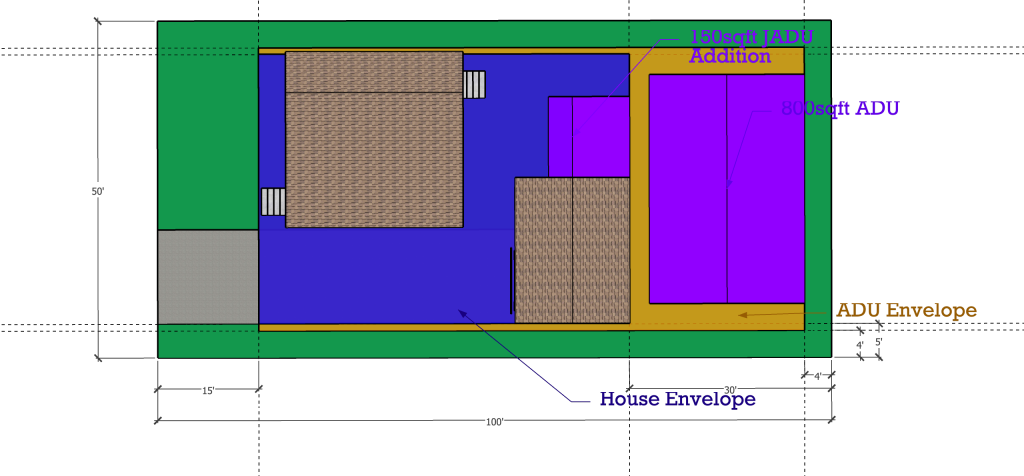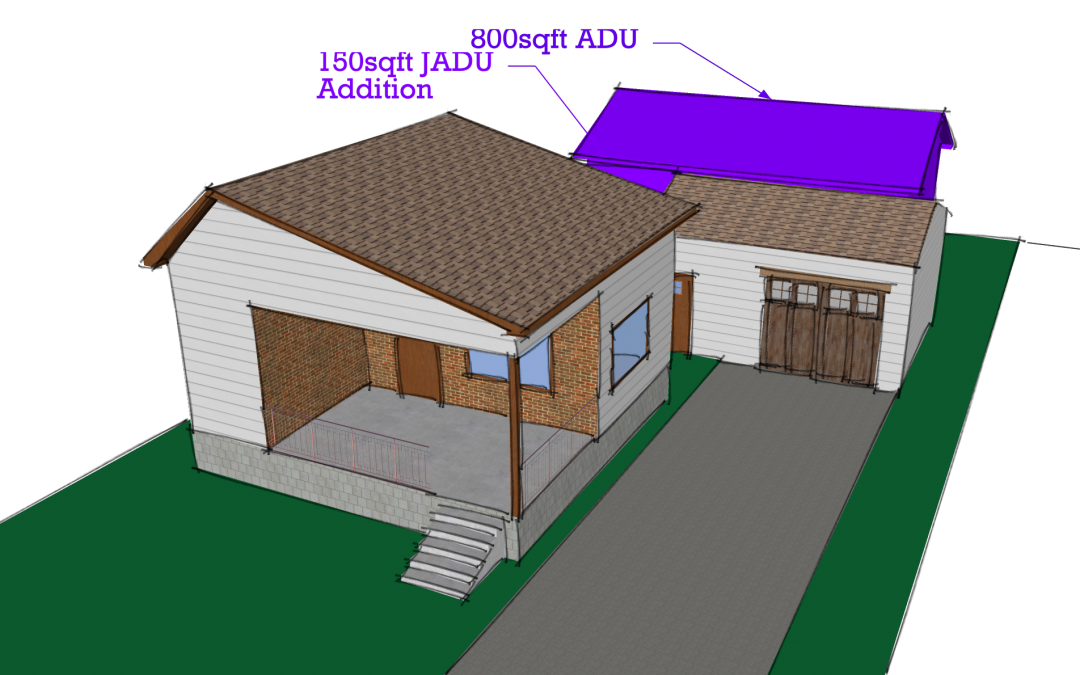Do you own a single family home in California, but wish you could do more than just advocacy to help the housing shortage? Congratulations! You can soon turn your one home into three thanks to this year’s state legislation on Accessory Dwelling Units (ADUs). Nearly all single-family properties in California will be able to add two more homes without the hassle of long public hearings, excessive fees, or even hiring an attorney to help navigate the process. Getting to a triplex can be tricky, however, so we are providing this roadmap for homeowners and builders who are interested in doing their part to solve the state’s housing shortage.
Don’t listen to the local ADU ordinance
The first step for many people looking to build an ADU is to visit their local planning department and ask what is allowed on their property. Others may try to do the job themselves and look at their local zoning ordinance to try to decipher the rules. With the new state laws signed today this process just became much more simple. That is because the new law expands the state-mandated ministerial approval process for certain ADUs that operates completely free from the local zoning ordinance. Some planning departments around the state may not see it this way, however, so it is worth outlining this interpretation of the new state law.
ministerial, adj: That which is done under the authority of a superior; opposed to judicial: that which involves obedience to instructions, but demands no special discretion, judgment, or skill.
Black’s law dictionary, 2nd ed
The state ADU law establishes a statutory framework that gives local governments two choices: adopt a local ordinance that complies with state law, or don’t and agree to process ADU permit applications under the state minimum standards. Of course, they can’t just pass any old ordinance; their ordinance is only allowed to regulate within the limited established under the state law. This framework for local regulations over ADU permits is contained in Government Code Section 65852.2(a) through (d). However, the following subdivision (e) establishes an independant permitting option that will guarantee most property owners the ability to add 2 more units regardless of conflicting local zoning rules. Any property with a proposed or existing single family home is guaranteed one new detached ADU and one Junior ADU as long as four foot setbacks are maintained and the new ADU complies with a 16 foot height limit. ADU plans that qualify for (e) may be permitted notwithstanding the state minimum standards, or any local zoning regulations that are authorized by the state law such as parking, height, setback, landscape, architectural review, maximum size, or historic resource review.
How to take advantage of the state ADU approval process
In order to get to a triplex, we need to look at a typical single family property in California to see what is currently allowed and what will be allowed once the new laws go into effect. The typical lot for a single family home in California is about 5000 square feet, and local zoning requirements mandate a 30 foot rear yard setback, 5 foot side yard setback, and an attached or detached 2-car garage.

After the new laws go into effect, the easiest way to triplex-ize such a property will be to convert the garage into a Junior ADU (JADU) and build a new, detached ADU in the backyard. The JADU must be contained mostly within the space of the existing garage or other accessory structure, with the addition of 150 sq feet allowed to provide for an entryway. The ADU may be located anywhere on the lot, subject only to 4 foot setbacks from the side and rear lot lines, a 16 foot height limit and a maximum footprint of 800 square feet.

There are, of course, other things to worry about. This is California, after all. You will need to get plans prepared to submit for the permit, make sure they comply with all applicable building codes, and get financing. These liberalized zoning requirements and a near-instant approval process, however, provide the simplest and fastest route to an ADU permit for most homeowners.
What to watch out for
Local governments will undoubtedly resist the implementation of these standards. If you are hoping to submit plans for two new units on January 1st, be prepared to be met with resistance in the form of any number of reasons given by your planning department. Some may say the floor area ratio or distance between buildings prevents approval. If you run into resistance, remind them that state law bars those restrictions. Flash your Avocado Watch Network badge, if you can. Others may ask you to provide parking for the new units or replacement parking for the garage conversion. Others may ask you to go through a discretionary design review process; something like a public hearing circus. All of these answers are in violation of the new state laws, and we want to know when and where it happens.
In each case, be ready to point out that subdivision (e) applies notwithstanding any local ordinance or the statewide ADU standards. Only the specific standards outlined in (e) apply: the JADU must be contained mostly within existing structures and the ADU must maintain 4 foot setbacks, a 16 foot height limit, and stay under 800 square feet. If your city still prevents you from triplex or duplex-izing even if you meet these standards, contact us! We are prepared to fight for more ADUs and will be looking for cities that ignore state housing laws. Ask San Francisco how that worked out for them.
CaRLA can help
It is difficult to understate how transformative these new ADU regulations are. The State of California has effectively ended single family exclusive zoning statewide, which tops even recent efforts by Minneapolis to end single family zoning. Climate change demands that we take radical action towards decarbonizing our cities, and triplexization of the state through ADUs are a big step in that direction.
To accelerate the implementation of these new ADU laws, we’re excited to announce the launch of our ADU Resource Center: Triplexize California! Check it out with the big button below. We’ve laid out easy to follow steps for any homeowner looking to do their part.
Be sure to sign up for our e-mail newsletter as well, and we’ll keep you up to date on developments in ADU law as cities around the state begin their local implementations.

